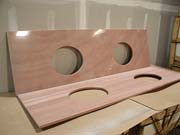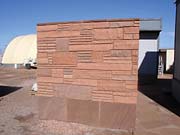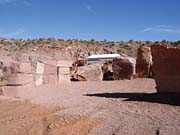

The Rainbow Quarry is expansive - covering approximately 920 acres - and sits outside Goodsprings, NV, which at one time was one of the largest mining areas (for precious minerals) in the U.S. The property itself differs from what most would envision of a typical quarry site. Areas where material is being carefully extracted are surrounded by Joshua trees and preserved wilderness. Mountain lions and other wild animals are also known to roam the land.
“We traced the quarry back to the 1920s,†said Steve Wickman, Vice President of Las Vegas Rock, explaining that while Las Vegas Rock has a lease to the quarry, the title to the property is held by the Simon family. “Pop Simon started running the quarry around the '40s or '50s, but after a time, sales kind of died out.†During their high school days, Peter, Pop's son who worked in the quarries from time to time; and Mike Kiddy, President of Las Vegas Rock, used to explore the area and learned much about the quarries.
Although originally from the Las Vegas area, Wickman had moved to California for awhile, “Mike called me one day and said, 'We should get Simon's quarry running again. Rocks are hot and I've got some great ideas.'†Although he admits to “having little faith†in his friend's vision at the time, Wickman reluctantly headed back to Las Vegas and started Las Vegas Rock with Kiddy in 1988. “It was during the water conservation efforts in the '80s,†said Wickman, which led local residents to establish “desert landscapes†instead of more traditional landscapes. “We were cleaning up the quarry and using the boulders for decorative pieces, and it caught on with the local landscapers, and in the late '80s, early '90s, the use for decorative stone exploded.â€
According to Wickman, the material has the aesthetics of sandstone but durability of quartzite. “It has a very remarkable range of colors from the same deposit,†he said, adding that hues vary from light pink to deep burgundy, making the name “Rainbow Quarries†quite literal. “We would originally let customers pick the color that they wanted, and then we would quarry it, but economically that didn't work. Now we sell more of a pink and a wide variety of rainbow hues, which are striated.†Currently, there are 13 locations within the quarry where different colors can be extracted.
Wickman went on to say that the meta-quartzite is a very hard, versatile stone that can be polished, honed, and used for a multitude of applications - even waterscapes. “We learned that the stone's porosity is not necessarily bad because it's consistent and accepts a sealer. It's like a sponge; it absorbs it all evenly. This is particularly valuable
in kitchen, bathroom and interior applications.â€
“We [first] came in with the desert landscaping,†said Wickman. “We started with the simple idea of desert stonescapes, and then moved on to structural stone. Now we're developing high-end uses for it. We really knew we had something when we saw the result of polishing. The integrity and appearance of the stone are absolutely beautiful.â€
At the present time, Las Vegas Rock outputs about 200,000 tons per year. “That's going to change dramatically once we get into the new products,†said Wickman. “The average boulder size that we are looking to get is between 10 to 20 tons, so we can drill it or square it up with a wire saw.â€
Machinery at the quarry includes Caterpillar excavators, D550 Caterpillar haul trucks and loaders; a Park Industries Hydra-Split; a Mitsubishi track hoe; Case forklifts and crushing equipment. “All of our production of the flagstone and ashlar is primitive,†said Wickman. “We need to become more automated. At this time everything is split by hand. We tried mechanized ways, but you have to have a feel and a talent for the boulder.â€
Las Vegas Rock employs about 32 workers, with some being part time. All of the employees except a few have been with the company for at least five years, according to Wickman. The quarry operates generally five days a week. “Last year we only lost one day due to weather,†he said.
Blasting is required in the quarrying process, according to Jorge Franz, who heads up the new division, Nevada Stone, which will concentrate on marketing the polished meta-quartzite product as well as imported material. “We're good customers of B-Gel,†Franz said, explaining that B-Gel is able to absorb the explosive effect. “It's a lot less damaging to the stone than others.â€

Developing a factory
In order to expand Las Vegas Rock's position in the stone industry, the owners decided it is time to build a fabricating facility after exhaustive research and development. The objective is to produce unique domestic tile and slabs for high-end uses.“It took us a long time to find what we felt would be the best cutting and polishing equipment,†said Franz. “We selected Thibaut because we felt it was best suited for our stone and operation.â€
Rather than trying to cut the meta-quartzite into traditional blocks out of the quarry, industry professionals have instructed Las Vegas Rock that it is best to square off the boulders. After that, the blocks can be cut into slabs and tiles.
Wickman said that his equipment selection was greatly assisted by Mark Gherardi of Buttura & Gherardi Granite Artisans of Barre, VT, who uses a Thibaut saw and polisher and offered to produce some of Las Vegas Rocks, material as a test.
Las Vegas Rock's new factory is ideally located in Jean, NV, with freeway and rail access, on 17 acres of land. “It's an old milling site that was used by Rainbow Quarries through the years,†said Wickman. The Thibaut wire saw and polisher are expected to arrive in April, and installation of the equipment should be complete in June. Until then, Buttura & Gherardi will be producing Las Vegas Rock's material.
The company is also giving calibrated tiles a try. “We have sent raw materials to Halquist Stone in Wisconsin, and also to China and Spain,†said Franz. “If it proves successful, we will continue.â€
Additionally, a new 9,000-square-foot warehouse was leased in October 2003, and will be the showroom for Nevada Stone. This new facility will house slabs produced by Las Vegas Rock as well as imports. “Las Vegas Rock has entered a new era,†said Franz, when explaining the function of Nevada Stone. “The biggest business for granite slabs is [new] homes. Three-thousand families are coming into Las Vegas every month.â€
The increase in population is evident when driving along the highways. Desert land that was once vacant now is filled with new residential communities. Even the property across the street from Las Vegas Rock's retail yard, which was desolate when the company moved there a few years ago, is now a large housing development. Las Vegas Rock has ambitions to capitalize on this booming construction industry

Other ventures
In addition to its slab and tile business, Las Vegas Rock also focuses on other specialty areas. Aquarius Stone Products is another division, which produces and sells engraved stone signage and monuments as well as stone furnishings, and it specializes in golf course tee markers and directional signs.Another product by Las Vegas Rock is soil-related and is being used for agriculture, sports fields and golf courses; it even meets some of the PGA requirements. Aquarius Soil (stone mulch) is ground pieces of meta-quartzite, and it retains the same porosity and “soaks water like a sponge, making it available for root growth.†Wickman said. “We're really proud of how efficient our quarry is. We have almost no waste.â€
Looking back on how Las Vegas Rock has grown over the years, Wickman is pleased with the company's gradual progression. “We are also currently engaged in negotiations with a silica sand - glass sand, etc. - producing partner to help fully utilize our unique stone deposit, he said, adding that it appears that the business will continue to grow along with the population in the Las Vegas area. “I never thought I'd be selling rocks in the desert,†said Wickman.
